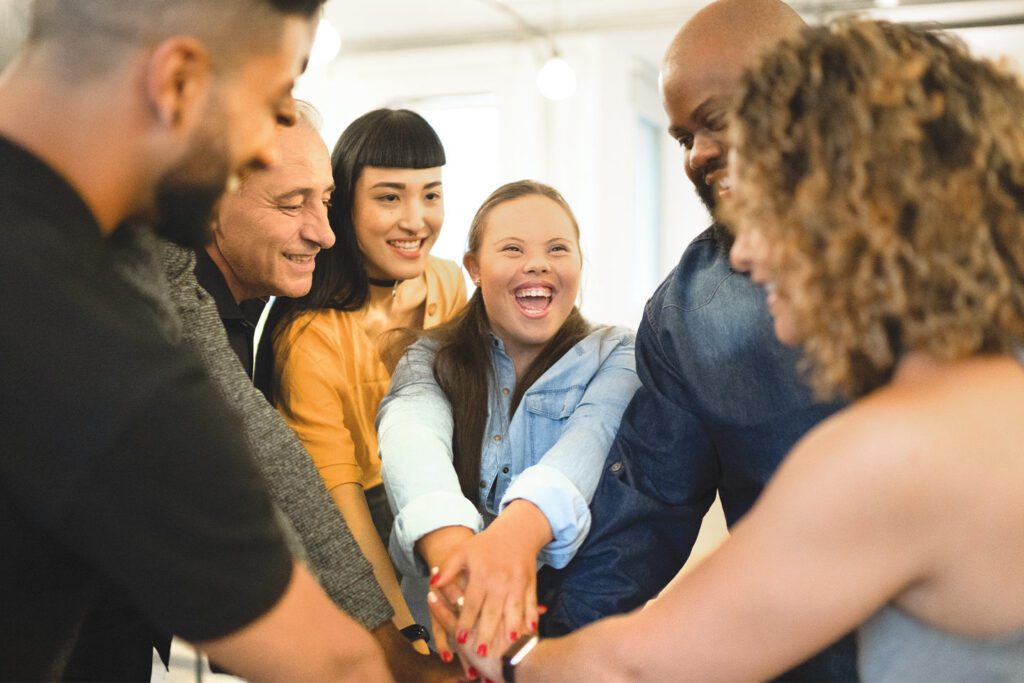Roughly 5,100 babies are born with Down syndrome each year in the United States, making it the most commonly diagnosed chromosomal condition. Despite this fact, however, misconceptions about life with Down syndrome abound.
What is Down Syndrome?
Down syndrome is a lifelong condition that occurs when a baby is born with an extra chromosome. Chromosomes are bundles of genes found in each cell of the body which dictate growth and development. Typically, infants inherit 23 chromosomes from each parent for a paired total of 46, but Down syndrome occurs when an additional chromosome is present in one of the pairs – specifically, the 21st – for a total of 47. This additional genetic material alters the course of typical development, resulting in Down syndrome.
There are three types of Down Syndrome:


- Trisomy 21 (≈95% of cases) – An extra 21st chromosome occurs in each cell.
- Translocation Down Syndrome (≈3% of cases) – An extra 21st chromosome occurs in each cell but is attached to another chromosome. This typically causes the same effects seen with Trisomy 21.
- Mosaic Down Syndrome or Mosaicism (≈2% of cases) – An extra 21st chromosome occurs in some cells, but not all. Depending on how many cells are affected, mosaicism can cause fewer of the traits associated with Down syndrome.
Each type can cause some of the traits commonly associated with Down syndrome, including physical traits such as flattening at the bridge of the nose, almond-shaped eyes that slant upward, small stature, low muscle tone with potential for loose joints, and a deep crease across the palm of the hand. There is also the potential for certain health complications. According to Dr. Yanez, “These medical conditions include hearing loss, obstructive sleep apnea, and thyroid illness. Most of these conditions are treatable, and individuals with Down syndrome can lead healthy lives.”
Additionally, Down syndrome can cause mild to moderate developmental delays. “Children with Down syndrome often have delays in gross motor skills, fine motor skills, and communication. Early intervention through therapy services such as physical therapy, speech therapy, or occupational therapy is highly recommended to meet the needs of these children by supporting or strengthening their skills in these areas,” says Dr. Yanez.
It is important to remember that each person with Down syndrome is a unique individual. The common characteristics associated with Down syndrome can show up in varying degrees from person to person; and just like people without Down syndrome, each individual will have varying abilities. Furthermore, especially with early intervention, these differences don’t have to hold people back from living happy, healthy, and fulfilling lives.
Treatments



Down syndrome itself is not a condition that has a singular treatment, so therapies and programs instead focus on maximizing an individual’s capabilities and addressing any challenges they may have. Physical therapy, speech therapy, and occupational therapy can help individuals with Down syndrome live their lives to the fullest. Early intervention programs exist to give children with Down syndrome access to these therapies as soon as possible, as they are very beneficial during early childhood development.
Physical Therapy
Because Down syndrome causes low muscle tone and the possibility of loose joints, physical therapy is very important.
Activities and exercises to strengthen muscles can help to prevent injury and improve motor skills. Early access to physical therapy can help children develop strength, improved posture, and fine motor skills that are useful throughout their lives. Furthermore, addressing any physical challenges can prevent children from developing compensatory movement patterns that can be detrimental long-term.
Speech Therapy
Children with Down syndrome often experience speech delays, but access to speech therapy early in life can make a significant difference. Speech therapists can help children develop the skills needed to form words, which include echoing sounds, looking at the speaker, the ability to listen to sounds and comprehend speech, and fine motor skills such as moving the lips and tongue. Starting speech therapy earlier in childhood can lay the foundation for stronger communication skills through adulthood.
Occupational Therapy
Occupational therapy focuses on developing skills to gain independence. For children, the emphasis is on the ability to turn knobs or use tools such as writing utensils, the ability to dress themselves, or the ability to play and interact with others. Occupational therapists will work with each child on an individual basis to address skills that are challenging and build on each child’s individual strengths.
The Importance of Inclusivity
In addition to the aforementioned therapies, children and adults with Down syndrome benefit greatly from inclusive social, educational, and work programs. “Individuals with Down syndrome attend school, vote, have relationships, and can contribute to society in enriching ways,” says Dr. Yanez. “It is very important for us to continue to promote accessibility, accommodations, and the presence of individuals with Down syndrome in schools and in the workplace as they have so much to give back and teach others across all age groups.”
Special education services support children in inclusive environments where they can play, learn, and engage with same-age peers.



According to Nix, who founded Downside Up after her son was born with Down syndrome, “Being in an inclusive environment with typically developing peers helps the child with Down syndrome interact socially in addition to their education. They learn by watching and participating alongside friends their age. But it’s also beneficial to the children without disabilities, because they learn to see the person rather than the disability and that they are more alike than different.”
For children and adults alike, nonprofits like Downside Up, which offers various programs for people with disabilities and their families, provide a place where everyone can be themselves, which helps develop confidence and decrease feelings of isolation. “People with Down syndrome have the same emotions and want the same things that everyone else does – friendship and acceptance,” Nix explains. The feeling of belonging that comes from attending school, work, or social gatherings can significantly improve an individual’s outlook on life and their ability to thrive.



Jenesis Yanez, MD
Developmental-Behavioral Pediatrics Specialist, Siskin Children's Institute



Theresa Nix
Founder and CEO, Downside Up

